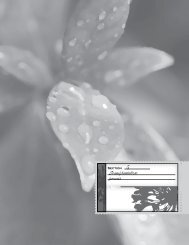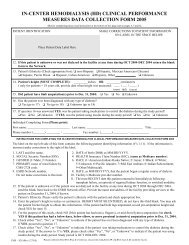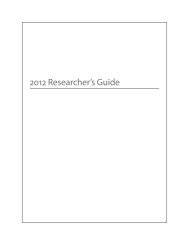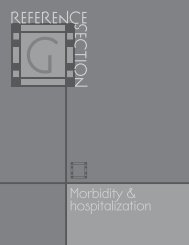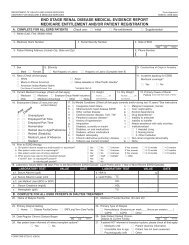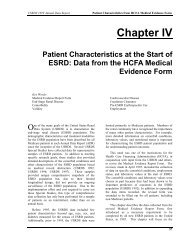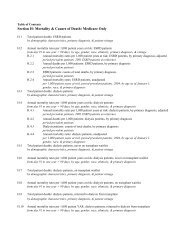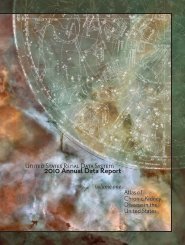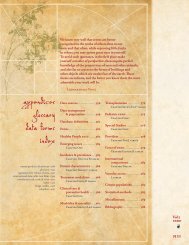Download - United States Renal Data System
Download - United States Renal Data System
Download - United States Renal Data System
Create successful ePaper yourself
Turn your PDF publications into a flip-book with our unique Google optimized e-Paper software.
plier claim, which is essentially a line-item record. One visit<br />
to a physician can generate multiple claims records.<br />
While there are only minor differences in the structure of<br />
the data included in the five institutional claim types (hospital<br />
inpatient, hospital and freestanding outpatient, hospice,<br />
home health agency, skilled nursing facility), the structure of<br />
the physician/supplier claims is substantially different from<br />
that of the institutional claims.<br />
Institutional claims are submitted on Part A claim forms,<br />
which have a large header portion followed by variable length<br />
trailers. Possible trailer fields include diagnoses, procedures,<br />
and revenue centers. Physician/supplier claims have a simpler<br />
header portion and fewer trailer fields, including the revenue<br />
center with a CMS Common Procedure Code Standard<br />
(HCPCS) procedural code. Unlike the International Classification<br />
of Diseases, Ninth Edition, Clinical Modification<br />
(ICD-9-CM) procedural codes on the institutional claims,<br />
which primarily record invasive surgical procedures, HCPCS<br />
codes record all procedures performed by physicians (e.g.,<br />
patient histories) and all supplies, ranging from Band-Aids<br />
to dialysis machines.<br />
Institutional Claims<br />
A “claim” file and a “claim detail” file are created from the<br />
institutional files. The details can be linked back to the claims.<br />
The Institutional Claims File has one record per claim, with<br />
a claim generally representing a single instance of service,<br />
such as a hospital inpatient stay, an outpatient surgery, or a<br />
month of dialysis. Dollar values for total and allowed charges<br />
are stored in the claim file, which also shows the type and<br />
number of dialysis sessions included in the claim.<br />
<strong>Data</strong> in the Institutional Claims File allow researchers to<br />
determine dialysis treatment modality over time, compute<br />
hospitalization rates, and determine aggregate costs by time<br />
period and type of cost. These data are sufficient for many<br />
research studies and most USRDS products. Analyses of<br />
particular diagnoses, procedures, or revenue centers require<br />
the claims detail file.<br />
Table B.1 shows the variables in the Institutional Claims<br />
file. The claims are uniquely identified by a compound key<br />
consisting of the first four variables listed in Table B.1. The<br />
records in the institutional claims files are sorted by this<br />
compound key.<br />
The derivation of the dialysis and EPO variables on the<br />
Institutional Claims record is described below under Revenue<br />
Center Details.<br />
Medicare Payment Variables<br />
CLM_TOT is the total amount billed for the claim, while<br />
CLM_AMT is the amount actually paid by Medicare. For<br />
Inpatient and skilled nursing facility claims, the cost also<br />
includes an amount for the CMS pass-through payments<br />
for items such as indirect medical education, capital, and<br />
kidney acquisition for transplants. To obtain this passthrough<br />
payment amount, multiply the per diem amount<br />
(PER_DIEM) by the count of covered days (CVR_DCNT).<br />
In addition to these overall amounts, the billed amount for<br />
dialysis and for EPO are provided by the variables DIAL-<br />
CASH and EPOCASH<br />
Dialysis Variables<br />
The variable RXCAT indicates the type of dialysis, if any,<br />
included in a claim. RXCAT is derived from DIALREVC and<br />
DIALCRC, which come from the Revenue Center and Claim<br />
Related Condition details, as described below. DIALSESS is the<br />
UNITS value from the Revenue Center detail which indicates<br />
dialysis. For in-center hemodialysis, this generally indicates a<br />
plausible value for the number of dialysis sessions. For other<br />
types of dialysis, particularly CAPD and CCPD, this may<br />
indicate the number of days. DIALCASH is REV_CH from<br />
the Revenue Center detail and is the provider’s billed charge<br />
rather than the Medicare payment. The Revenue Center and<br />
Claim Related Condition details, which indicate dialysis, are<br />
not included in the Institutional Claim Details file unless the<br />
claim has multiple details which indicate dialysis.<br />
EPO Variables<br />
Summary variables are provided for EPO treatments covered<br />
by a claim. EPO treatments are identified by Revenue Center<br />
codes 0634 and 0635 and by HCPCS codes from Q9920<br />
through Q9940 on a Revenue Center detail. The variable for<br />
number of EPO administrations (EPOADMIN) is the UNITS<br />
variable from the Revenue Center detail, while the variable for<br />
EPO payments (EPOCASH) is the REV_CH variable. If the<br />
claim has multiple Revenue Center details indicating EPO, the<br />
EPOADMIN and EPOCASH are summed over these details.<br />
The Revenue Center details from which these variables come<br />
are not retained in the Institutional Claim Details SAF.<br />
The variables for the dose of EPO (EPODOSE) come from<br />
a Claim Related Value detail with code ‘68’, and the variable<br />
for hematocrit (HCRIT) comes from a Claim Related Value<br />
detail with code ‘48’. The Claim Related Value details from<br />
which these variables come are not retained in the Institutional<br />
Claim Details SAF.<br />
Institutional Claim Details<br />
The Institutional Claim Details file includes a variety of details<br />
about each claim. The records in this file can be linked<br />
back to the corresponding claim in the claims file. There may<br />
be none, one, or many records for each type of detail for a<br />
particular claim.<br />
♦ ICD-9-CM diagnosis codes<br />
♦ ICD-9-CM procedure codes<br />
♦ CMS revenue center codes (line item)<br />
♦ HCPCS procedure codes (with line item)<br />
♦ CMS claim related condition codes<br />
♦ CMS claim related value codes<br />
Table B.2 shows the variables appearing in the Institutional<br />
Claim Details file. There can be any number of Institutional<br />
Claim Details records for each Institutional Claims record.<br />
The claim detail file is sorted by the same four-part compound<br />
key as the Claims file, so that this key can be used to<br />
link the two files.<br />
The two-file structure is a solution to the problem of a<br />
number of important data items that appear to be zero one<br />
or many times in a given claim. Hospital inpatient stay claims,<br />
for example, always have DRG codes, but other types of institutional<br />
claims never have this code. All claims should have<br />
50 e Appendix B Medicare Claims



